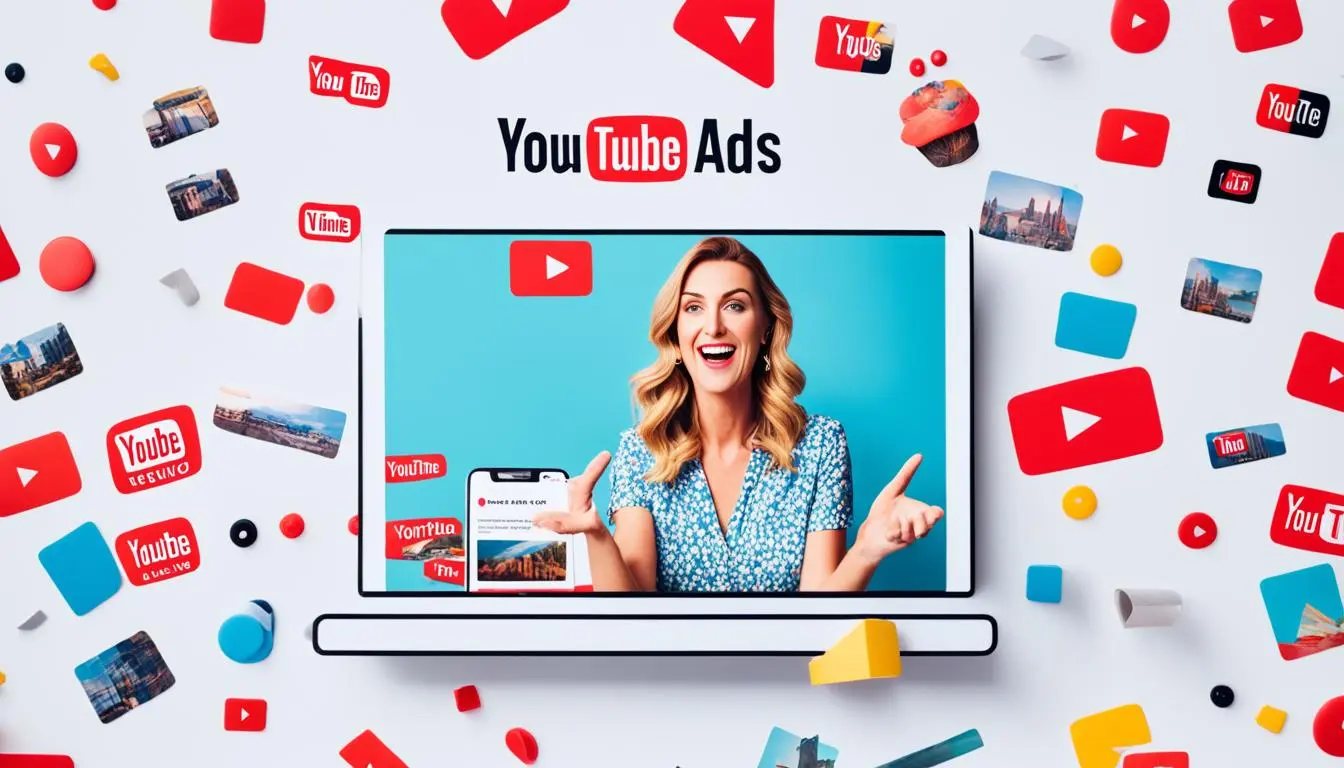In 2024’s marketing world, brand growth and connecting with customers are key. Where is your brand in the fast-changing digital market? Over half the working world wants to use AI for better data1. An incredible 90% of shoppers like seeing personalized ads1. This means using new tech and trends is crucial. Today, it’s not just about ad plans. It’s about mixing digital and online plans to market well anytime.
Shoppers are leaving more online tracks everywhere. So, businesses must get ready for this shift by using tools like AI together. This lets them act fast with marketing but keep that personal touch most shoppers love. They believe your company’s vibe is just as important as what you sell1.
Key Takeaways
- AI for better data and tasks is now a must-have1.
- Influencer marketing and live videos make brands more trusted and real1.
- Spending on content made by users and personalized ads is up, even with less money1.
- How good a customer feels about their experience ties with product quality for their loyalty1.
- By 2030, virtual and augmented reality will change how we do marketing1.
Exploring the Impact of AI on Future Marketing Strategies
AI is changing how we do marketing. AI tools are crucial today. They help us stay ahead in the digital market. Brands are using AI to better connect with people, improve their marketing efforts, and forecast trends.
Anticipating Trends with AI Analytics
AI plays a big part in understanding what customers want and managing campaigns. It looks at a lot of data quickly to spot patterns. This helps target customers better and adjust to new marketing trends fast2.
Personalization and Automation with AI Tools
AI tools make marketing more personal than ever. They study how people act and what they like, then adjust ads to fit them better. Doing this makes customers happier and boosts sales2. Also, AI can do many tasks automatically, like sending emails or posting on social media. This frees up time for the marketing team to do more creative work2. Studies show that using AI in an ethical way is key. It helps protect our privacy and keeps AI marketing effective over time3.
Improving Customer Interactions Through AI Chatbots
AI is also making a big difference in customer service. Chatbots are always available to help. They speed up the time it takes to get a response, making customer service better. This kind of support all day, every day, means customers are happier and more likely to stick with the brand.
Using AI in marketing makes everything smoother and more personal. It’s a step up from traditional ways of reaching out to customers. With how fast technology is changing, AI is now a must for brands that want to market efficiently and ethically.
Adapting to Privacy Changes in Target Marketing

In digital advertising‘s changing scene, the spotlight on privacy changes is changing how marketers see online marketing. The move away from third-party cookies is pushing brands to look for new targeting solutions that meet fresh privacy rules. They want to keep ads personal and on point.
Data shows 97% of people are worried about their personal info safety4. This has made companies focus more on keeping consumer data safe. About the same number of them are planning to invest more in data protection4. Now, AI modeling is a key player, offering insights without invading privacy.
- Almost one out of five marketers now view privacy compliance as a critical challenge across marketing channels4.
- Meanwhile, misuse of user data could prompt approximately 80% of customers to sever ties with brands4.
- 73% of marketers are concerned about privacy regulations negatively impacting their analytics capabilities4.
Today, brand relevance means finding a good mix between custom ads and privacy. The rise of privacy-preserving technologies like federated learning and differential privacy offers hope. These techs let marketers get insights from grouped data without exposing anyone’s personal info5.
| Privacy Approach | Benefits | Focus Area |
|---|---|---|
| AI-Driven Predictions | Enables personalization without direct data access | Consumer behavior |
| Contextual Advertising | Ad relevance based on content, not user data | Webpage content5 |
| Zero-Party Data | Direct consumer input ensures compliance | User preferences5 |
| Privacy-Preserving Tech | Protects user anonymity while providing insights | Data aggregation5 |
As more companies work under rules like the GDPR and CCPA5, they’re moving to smarter and more respectful advertising. This means ads that are still personalized but put user privacy first.
This change matches global privacy standards and shows a clear dedication to ethical marketing. It’s about keeping consumer trust strong and making sure your brand is known for doing the right thing in every part of online marketing.
Leveraging Influencer Collaborations for Authentic Engagement
In today’s world, influencer marketing is crucial for brand growth. It helps reach more people and build lasting relationships. Building trust is key. When done right, working with influencers boosts a brand’s presence and connection with customers. We will look into key strategies for successful partnerships. These include strong digital content and effective social media plans.
Building Long-term Partnerships with Influencers
Working with influencers is not just for one-time deals. It’s about creating a journey that benefits everyone. Even though they might have fewer followers, micro-influencers often get more people involved. They are also a more budget-friendly choice for many brands67. To make these partnerships work, there should be regular talks, shared values, and a real connection. It’s also important that influencers tell their followers when they’re partnering with a brand. This keeps everything honest and builds trust68.
Maximizing Exposure with Live Streaming Events
TikTok, Instagram Reels, and other live streaming platforms let influencers engage with fans in real time. This not only makes a brand seem more human but also widens its reach during live sessions. It allows for immediate feedback and interaction with viewers. Looking at how well these events do helps brands adjust their future strategies6.
Live streaming is also great for keeping people interested and entertained. It lets brands be creative and show off their products in fun, interactive ways6.
| Strategy | Benefits | Keywords |
|---|---|---|
| Long-Term Influencer Partnerships | Higher engagement, Authentic promotion, Cost-effective marketing | Influencer marketing, Trust-building, Long-term collaboration |
| Live Streaming Events | Real-time interaction, Immediate audience feedback, Enhanced brand awareness | Live streaming, Social media marketing, Digital content strategies |
To wrap things up, influencer collaborations demand smart planning and strong social media strategy. Striving for long-term partnerships and using innovative tools like live streaming can grow your brand awareness significantly6. Staying real and flexible in the ever-changing digital world is crucial for success.
User-Generated Content as a Trust-Building Tool
User-generated content (UGC) is becoming vital in digital marketing. It helps brands connect with their audience in a real way. This happens by sharing real customer stories and feedback. These genuine voices boost trust among potential customers.

Incorporating Customer Stories in Marketing Efforts
UGC makes brands more credible and influences what customers buy. Studies show 93% of people check reviews online before making a purchase9. Showing real reviews and testimonials increases trust and credibility10. Businesses sharing customer stories also appear more open and easy to relate to. This improves their image and keeps customers coming back9.
Capitalizing on Viral Trends and Hashtags
Getting involved in digital trends and using hashtags helps brands get noticed. Content that joins in on viral trends gets seen a lot. This boosts a brand’s visibility on social media sites like Instagram and Twitter10. Using the right hashtags not only organizes posts but also helps in reaching new people. This keeps brands in the game in the online world.
When brands use UGC, it can improve their search engine ranking and authority9. Teaming up with influencers and advocates helps, too. It makes the brand reach more people and build stronger trust through bigger engagement910.
At its core, UGC helps with brand authenticity. It also encourages real participation in social media. This is key in the digital world today.
Hyper-Personalization for Enhanced Customer Experience
Today, hyper-personalization shapes successful marketing strategies. It’s based on using big data and machine learning tools. They help find and deliver targeted content. This content makes the customer experience better by fitting their likes and actions.
About 92% of companies use AI-driven personalization. This practice has really fueled their growth11. In banking, designing personal customer interactions can lift sales by 20%11. Similarly, the travel industry has seen a 23% increase in sales thanks to suggestions based on user info11.
Personalized advertising shows in the numbers, too. 90% of marketers say they get better results, like more sales and happier clients11. Plus, 62% of business heads think it helps to keep customers around11.
- Increased revenue through personalization in banking11
- Spiked conversion rates in travel from personalized recommendations11
- Improved customer satisfaction from personalized strategies11
But, setting up personal systems can be hard. Around 30% of B2C marketing leaders say managing data is a big obstacle12. They highlight how firms need to wisely use and protect customer data.
McKinsey’s findings are quite promising. Good personalization can cut down on costs and boost revenues. Plus, it can make marketing more efficient12. Yet, most customers feel let down when they don’t get the personalized service they hope for12. This puts pressure on businesses to do better.

Data security remains a critical concern, as only about half of consumers trust brands with their data11. So, businesses should focus not just on personalization but also on earning and keeping that trust. This means handling personal data carefully and openly.
| Impact Area | Revenue Increase | Consumer Trust Levels |
|---|---|---|
| Banking Sector Personalization | Up to 20%11 | Low |
| Travel Personalization | 23% Conversion Boost11 | Medium |
Using the latest tech and respecting data privacy is key. It helps create personal journeys that connect with customers. This, in turn, boosts satisfaction and loyalty.
Optimizing Cross-Device User Experiences
In today’s world, making the user experience great on all devices is a must. With the trend of multi-device optimization, businesses must improve how users interact with their sites. This change helps keep users interested and involved. It makes sure every step they take, no matter the device, feels the same.
Voice search is important here. Adding voice search makes sites easier to use and aligns with how people like to search. As more people use voice search, making it work for your site can also help with SEO.

Driving Engagement with Voice Search Optimization
Many people now use voice search to look things up. This trend can help attract new customers at the beginning of their search. Voice search makes things more convenient for people. It also helps businesses stand out in a crowded market13.
Strategic Use of UX Design for User Retention
Good UX design keeps users coming back. By making websites simple and easy to use, companies improve the experience. Tracking users across different devices can also help create better, more personal experiences. This approach helps keep users engaged and can lead to more sales13.
Using the right cross-device tracking technologies is critical. These tools offer insights into what users do across devices. They also help companies deliver content that feels personalized. This helps in building brand loyalty and making users feel more connected.
By focusing on UX design and new technologies like voice search, companies can greatly improve the user experience. They can keep users happy by meeting their needs at every digital step.
Embracing Video Content and “Scrollytelling”
Today, the digital marketing world is changing. Video content and scrollytelling are leading the charge. They make brands connect better with people online. These tools go beyond looking good. They help websites tell stories that grab hearts and minds.
Video is great at showing ideas in a way we all get. It pulls in many different people. When scrolling through a page, scrollytelling keeps them interested longer. This new method has made visiting websites more fun and interactive for everyone. It keeps them reading and exploring more14.
Scrollytelling mixes visuals, text, and moving pictures into a cool journey. It makes stories stick in our minds better. This is because our brains love images, helping us remember things more15.
Using tools like WordPress and Webflow, creators can craft stories that scroll horizontally. This makes websites more fun to explore. It works well on any device, keeping everyone engaged equally16. But, make sure the page loads fast. Nobody likes a slow site.
It’s key to test these stories with real users. This ensures they work well and make visitors share them more1614. A good balance between cool visuals and deep info keeps the story interesting. It stops people from feeling overwhelmed14.
To see how effective scrollytelling and video content are in marketing, check the table below:
| Feature | Impact on Engagement | Key Benefit |
|---|---|---|
| Video Content | High | Improves message delivery and audience retention |
| Interactive Elements | Medium to High | Increases user interaction and time spent on page |
| Seamless Narrative | High | Enhances storytelling, making content memorable14 |
| Responsive Design | High | Ensures accessibility across all devices14 |
Brands need to use these new methods to shine online. They fit today’s trends and prepare for what’s next in content. By telling stories with videos and scrollytelling, they’re making their mark.
Fostering Brand-Consumer Relationships with VR
In today’s digital world, the border between the real and virtual is fading fast. Virtual reality (VR) and augmented reality (AR) are changing the game in marketing. They create immersive spaces that alter how buyers engage with brands. This change makes connecting with brands deeper and more interesting.
Augmented Reality for Personalized Shopping Experiences
Thanks to AR, shopping is becoming a personalized adventure. Customers can check out products in real time using just their phones. The fun and hands-on approach boosts satisfaction and gets shoppers excited. Companies such as Sephora and IKEA have led the way with AR. They offer apps that let you virtually try on items and see products clearly. This bridges the gap between shopping online and in person.
Virtual Showrooms and Product Demonstrations
Virtual showrooms through VR are a big hit. They let potential customers walk through a digital space and check out products like they’re there. This is especially helpful in areas like real estate. Buyers can now look around houses and personalize features without having to visit in person. VR’s immersive nature makes these digital encounters not just rememberable but also influential in making choices.
With virtual product experiences, companies can showcase their goods’ features and beauty in a perfect setting. This could attract more buyers from far away and meet their preferences better. The result is better marketing overall.
Adding VR to marketing is thrilling for customers. They get to interact with products in a new, exciting way. As we look to the future, such tech will be key for creating these virtual product experiences and raising the bar in how brands and buyers connect.
To dig deeper into how AR and VR can up your brand’s game, check out this detailed overview.
Integrating Simplified Analytics and Tagging Systems
The marketing world today needs a simple yet deep way to use data. Google Analytics 4 is leading this big change. It helps organizations use data better in their marketing by focusing on what users do and using better ways to track them.
Transitioning to Google Analytics 4 for In-Depth Insights
For businesses to better their marketing, switching to Google Analytics 4 is key. This new set of tools gives a full look at how users act across platforms. It makes tracking and predicting what customers will do much better. Plus, it connects well with Google Tag for a clear view of analytics everywhere17.
Centralized Campaign Management for Efficiency
Today, managing campaigns well needs joining all systems into one efficient place. With tools like Google Tag Manager, you can handle all tags without coding. This makes things go faster and less likely to have mistakes17. It also means setting up campaigns better and shifting quickly with market changes is a lot easier.
Adding Google Tag Manager boosts website speed by making code simple through easy tag management17. It also makes tracking better by fitting perfectly with Google Analytics 4. So, you get deeper looks into your marketing’s success17.
By using these top tools, companies stay ahead in tech and understanding their customers. This leads to smart choices in marketing that really grow their businesses.
| Feature | Benefits |
|---|---|
| Centralized Tags Management | Efficiency in campaign setups, reduced errors |
| Cross-platform user insights | Comprehensive view across all interfaces17 |
| Simplified Analytics | Better data measurement for strategic decisions |
The strong link between Google Analytics 4 and Google Tag Manager makes campaigns easier and more effective. This prepares marketers to handle the complexities of modern digital marketing well.
Incorporating CTV and Advanced Measurement Tools
Connected TV (CTV) is becoming a key part of today’s advertising world. It’s helping companies reach more people and make the most of their ad budgets. With more people using CTV, smart ads that match your tastes are on the rise. This is making advertising better and more personal for everyone18.
Almost 8 out of 10 U.S. homes have a streaming service now. And about 2 out of 3 people watch CTV. Such a big audience means CTV is changing how we see ads. Experts predict we’ll see a lot more ads here in the coming years. But, measuring these ads and making sure they work is tricky. That’s where smart tools come in, to help fight things like fake ad views and make sure ads are seen by the right people19.
CTV is all about personal ads now. By knowing what you like, ads can be more interesting. This move to smart, data-led ads is key. It helps ads tell stories that really speak to you. Plus, the tech behind these ads also makes sure they don’t show up too often. This way, their meaning stays strong, even with all the other online stuff going on18.
- Enhanced personalization through data-driven targeting18
- Increased reach with growing CTV adoption rates19
- Efficient campaign management with advanced analytics18
CTV and smart ad tools are changing the ad game. They are bringing new ad types and better ways to buy ads. Marketers are getting tools that are more advanced, making digital advertising smarter for everyone18.
Conclusion
Success in today’s digital world is about more than using new tech. It’s about making strategies that add value and connect with people. With smart analytics and new tech like AI and AR, brands can grow a lot and make a big impact.
Digital success comes from matching your marketing plan with what customers want. This might mean using personalized content that speaks to them. Or it could be telling great stories through video. The goal is to build a real bond. This connection keeps customers coming back. We measure success with things like ROI and CLV, which show the value of the relationship brands have with people20.
For companies looking to have good ads and strong marketing plans, keeping up is key. You need to blend new digital methods with what we’ve always known about the way people think. By staying flexible and planning well, brands lead the way to a future where marketing is about steady, meaningful progress, not just quick sales.
FAQ
How crucial is a dynamic marketing strategy for brand growth in 2024?
In 2024, it’s key for brands to have a dynamic marketing strategy. This is because technology is rapidly evolving, and so are consumer behaviors. To keep up with these changes, brands must always be ready to adjust and predict market trends. Creating a strong strategy that uses digital marketing, SEO, and content marketing can give brands a big advantage.
What role does AI play in shaping future marketing strategies?
AI is changing how we do marketing. It helps us understand data better and improves how we talk to each customer. With AI, businesses can predict what’s coming next, offer great customer service with chatbots, and carry out conversations online. These are crucial for digital marketing success in 2024.
How are marketers dealing with privacy changes and data restrictions?
Marketers are finding new ways to target their audiences while keeping their data safe. They are using AI and looking more at the data they collect directly from customers. This shift is helping them stay relevant in digital ads without relying on outside cookies.
Why are influencer partnerships critical for brand authenticity and engagement?
Influencers are now vital for making brands feel real and connecting with people. By working with the right influencers and using social media well, brands can build trust. This helps them create digital content that really speaks to their audience on the platforms they love.
How does incorporating user-generated content benefit a brand’s marketing strategy?
Adding user-generated content (UGC) makes a brand’s story more real and spreads it online. Things like customer reviews, unboxing videos, and fun campaigns can catch on and start a buzz. This builds a community vibe around the brand and lets customers join in the storytelling.
In what ways can hyper-personalization improve customer experience?
Hyper-personalization truly ups the customer experience. It tailors marketing to what each person likes and does, using big data and learning machines. This approach makes customers feel seen and valued, boosting their interest in the brand and loyalty.
How important is optimizing for cross-device user experiences in 2024?
Making sure your brand looks good on all devices is vital in 2024. Great user experience designs, with things like voice search and SEO, keep people coming back. It makes the brand easy and fun to use, no matter the device.
What makes video content and “scrollytelling” effective for engagement?
Videos and “scrollytelling” draw people in with powerful storytelling. They make the experience more interactive and memorable, which helps people remember the brand. It creates valuable connections on digital and social media.
How does VR and AR technology contribute to enhancing brand-consumer relationships?
VR and AR bring unique, interactive experiences that connect brands with consumers in exciting ways. They offer things like personalized shopping and virtual showrooms, making brand interactions fun and unforgettable. This can help build strong loyalty and set a brand apart.
Why is transitioning to advanced analytics platforms like Google Analytics 4 important?
Moving to tools like Google Analytics 4 gives better views of customer actions. It helps businesses manage their campaigns and understand their data in one place. This leads to smarter decisions in marketing, making strategies more effective.
What are the advantages of integrating Connected TV (CTV) into a marketing plan?
Adding Connected TV (CTV) to a marketing plan lets brands reach people in a growing digital space. It offers new ways to measure success, helping companies reach their audience better. This leads to digital advertising that’s smarter and uses resources well.
Source Links
- https://asana.com/resources/marketing-trends
- https://adsmith.biz/impact-of-ai-in-marketing/
- https://www.linkedin.com/pulse/exploring-impact-artificial-intelligence-marketing-through-chavolla-n6ulc
- https://www.marketingevolution.com/knowledge-center/data-privacy-issues-in-data-driven-marketing
- https://www.cmswire.com/digital-marketing/will-targeted-advertising-survive-privacy-legislation/
















